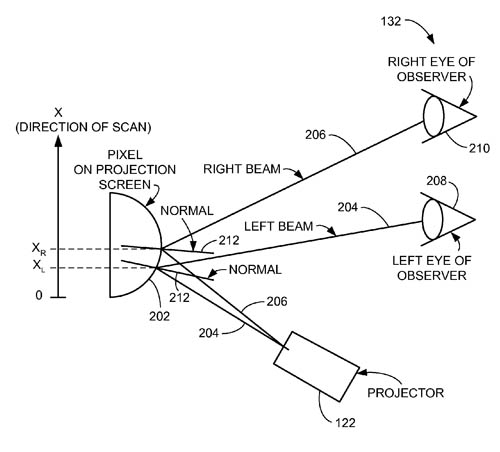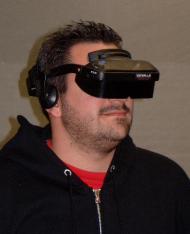2010 (A)R-evisited
Happy new year, may all your dreams come true!
After a brief break to catch our breath and have a much-needed holiday, Synthetic Toys is back up and running. This time we attempt a recap of 2010 in the area of Augmented Reality (AR). AR has drawn much attention through the past year, almost a decade after we started working on the subject. Although the ‘hype’ surrounding the field is quite a lot we are still skeptical about recent ‘advancements’ and how these will shape the way AR evolves. We will attempt to look into things aided from notable sources and offer our predictions and hopes for the field in 2011. One thing is for sure. AR is as interesting as it ever was, if not more, now that people begin understand its idiosyncrasies and pitfalls as well as its potential.
Handheld AR
Handheld AR is probably the sector that became more popular during 2010 with many companies offering AR-related applications, attracting lots of public attention [3,6]. Companies like Layar, Wikitude, Metaio and Qualcomm presented applications within this paradigm. The general idea is to use a smartphones modalities – GPS, compass, camera and wireless/GSM – in combination to superimpose 2D and 3D information in space using primarily the phones screen as a presentation medium. Examples of each company’s approach can be seen on their websites. In our minds we separate Handheld AR applications in two categories. Those that use a tangible reference for registration – like Qualcomm’s game using a camera tracked marker – and those that use a non-tangible one, like GPS and compass. Marker-less registration kind of falls between these categories but can be potentially more important.
Qualcomm & Mattel on Augmented collaborating on Reality
We at Synthetic Toys are thrilled with the current popularity of AR but can not help to remain skeptical on how current, marketing-driven, popularity can lead to the maturity of AR. But more of this further on…
3D Displays
3D Displays – HMD-less or not – have also gained lots off attention the last year, due to the appearance of blockbuster titles like Avatar in 3D. Big players like Sony, Panasonic, Toshiba, Mitsubishi and Philips introduced such displays in the market, in an effort to capitilize on the technology. Generally, HMD ones are not as easy to use due to various issues such as ocular and non-ocular symptoms, as commented on a previous post and require further research [10]. For this reason many researchers, including companies like Apple and Microsoft experiment with 3D displays that do not require a spectacles-type apparatus, but instead rely on different modalities to determine orientation of gaze [11]. Although the currently available solutions are at their infancy we feel this paradigm is quite promising and there is lots of potential and opportunities for research. Particularly, in conjunction with smartphones, where viewing distance is more or less easily determined, such displays can enhance handheld AR to another level, without requiring from the users to wear ‘dorky’ HMDs.
Kinect
Right from the moment of its release, Microsoft’s Kinect became a very popular gadget with hackers, with open-source drivers appearing immediately after its European release. Kinect can have a sizeable impact in the field, as many believe it is one of the best AR-related sensors in the market. Anything that can provide information on the user’s movements in real time has to be pretty useful in AR context. James McQuivey, Consumer Product Strategy analyst at Forrester, had written two weeks prior to the release of Kinect that it “is to multitouch user interfaces what the mouse was to DOS. It is a transformative change in the user experience, the interposition of a new and dramatically natural way to interact — not just with TV, not just with computers — but with every machine that we will conceive of in the future.” [4]. He further asked [5] “What will we call the new experiential medium that will result from natural user interfaces+3D+touch interfaces+augmented reality — technologies which are all conspiring in this decade to alter our lives?”
Augmented reality with hacked Kinect
Most researchers have used it to control software like word processors or games, like World of Warcraft depicted here but it is quite reasonable to foresee its use in AR applications. The popularity of Kinect is quite high and you can find some really nice AR-related experiments, such as the ones depicted in the video above, over the web. Moreover, the technology behind Kinect – or indeed part of it – may soon be available to PCs enabling researchers and developers to use it in different scenarios with greater ease. For us Kinect does one simple thing. Places the sensory modalities ‘away’ from the proximity of the user. Now, how about making a 3D display that is away from the user, independent of viewing distance and angle and… oh yes, we talked about that on the previous section…
Standardisation
One of the subjects often discussed in workshops and conferences is the need for stadardisation in AR. Many of the aforementioned AR players, researchers and institutions have debated on whether it is time for AR to have such standards. Granted standardisation does offer some benefits through unification, interoperability, reliability and predictability.
We feel that AR standardisation deserves a thorough examination and we will look into the subject in detail in the future. We are also keen on seeing the results of an AR Standards Meeting in Barcelona on February, expected to attract the interest of many important players in the field. However, we feel its a tad too early, mainly because we are reluctant to believe that AR has matured enough and that the current ‘call’ for standards is more market-driven than a technological necessity.
And that brings us to…
Our opinion
2010 was a year with a lot of publicity of AR, with many people getting involved and lots of new ideas flying around. But that is not necessarily a good thing. Augmented Reality has been around for quite some time – we’ve been researching it for over a decade – and approaching the field with the ‘naivety’ of modern marketing will not get far. In fact we are afraid that people are ‘over-hyped’ with AR and they will be disappointed soon, once they find the technology has limitations at the current state of things. Most of the market hype is driven from the, undoubtedly clever and successful, publicity methods of the big players. Handheld AR in particular seems a very easy way of getting people to know the concept and getting a hands-on experience. And that is the way it should be during the beginning. But lets face it, after a while is simply a gimmick. And that is attributed, in our eyes, to the limitations of current technologies, particularly when related to registration and the level of immersion of the presentation. Moreover, the next set of services and applications will not only need to exploit technological advancement to the fullest but will also some ‘out-of-the-box’ thinking to devise new paradigms. But lets get into the gist of things…
Handheld AR is probably the flavour of AR that will remain fairly popular due to the evolution in smartphones and tablets. However, there will soon be dire need for new types of services that enhance the user’s day-to-day routines and reality. Enhancing the latter does not necessarily mean placing high quality 3D graphics around. Enhancement also can come as any type of information, whether visual, audible or as tactile feedback.
Mechanics allowing tethering and location awareness are of course of paramount importance. However, increasing accuracy and performance while maintaining multi-modality will allow more complex – not complicated – frameworks to develop new services. We also feel that interaction between users, within the AR space much like a shared environment can have an important role is the sense of immersion of users.
Leaving the domain of Handheld AR behind and speaking in more generic terms, Interfaces in the context of AR are always a very challenging subject. Although some progress has been made on non-HMDs, very little improvement has been observed in HMDs – and to that we have to agree with Tom Carpenter [6]. Bearing in mind our own experience with HMDs and the sense of immersion they bring to the table there is still a lot to be done to investigate different technologies as well as the side effects of HMD usage. Naturally, we await with great interest the developments on the glass-less front.
If one thing has advanced considerably and will continue to do so, pushing AR development further, is processing power, particularly in small form factor platforms. Smartphones are capable these days to render complex graphics with very good frame rates. Consumption and battery longevity is indeed an issue but not so much as in the past. Although technically it belongs to 2009, Epic’s demonstration of the Unreal Engine 3 on IPhone, shown bellow, aptly demonstrates what these handheld beasts can do.
iPhone 4 Unreal Game – Project Sword
Concluding, we have to admit our review is nowhere near as extensive and detailed it could be. We gathered the things that had made an impression to us, those that we feel are the more important ones. We are certain we missed something and that our assessment may be erring a bit on skepticism. We are, nonetheless. very excited about the publicity AR is receiving and we are also planning on ‘playing ball’ within the current market with some ‘gimmicks’ of our own.
References
[1] The Year in Computing
[2] Eye-tracking for mobile control
[3] The Year in Enhancing Reality
[4] Get Ready for Kintetic to Completely Change our Lives
[5] Killing Me Softly With Kinect…And Leading Me To The Next Big Thing
[6] Augmented Reality – Year in Review – 2010
[7] Android 3.0 Honeycomb has Google-Built in Augmented Reality?
[8] Has Augmented Reality Peaked?
[9] Augmented Reality: Pure Hype or the Next Big Thing in mobile?
[10] Is 3D bad for you?
[11] 3D without four eyes




Follow Us!